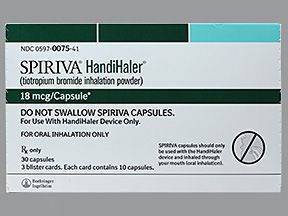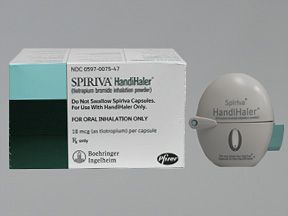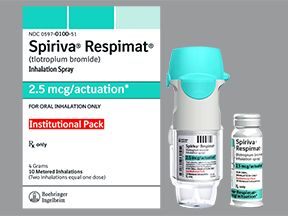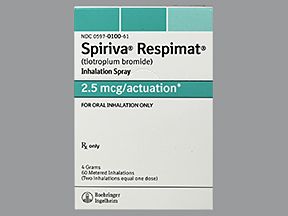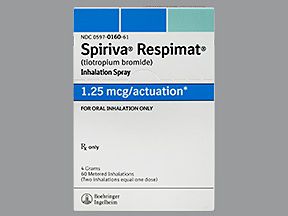Spiriva (tiotropium) is a brand-name drug that’s prescribed for COPD in adults and asthma in adults and some children. Spiriva is available as two different inhalers that are typically used once per day.
Spiriva comes in two forms, which have slightly different uses approved by the Food and Drug Administration (FDA):
- Spiriva HandiHaler: This form is used to treat chronic obstructive pulmonary disease (COPD) in adults.
- Spiriva Respimat: This form is also prescribed to treat COPD in adults. It can also be prescribed to treat asthma in adults and children ages 6 years and older.
Both forms of Spiriva contain the active drug tiotropium. Spiriva belongs to a group of drugs called anticholinergics. Neither form of Spiriva is currently available as a generic.
Keep reading for specific information about the dosage of Spiriva, including its strengths and how to use the medication. For a comprehensive look at Spiriva, see this article.
This article describes typical dosages for Spiriva provided by the drug’s manufacturer. When using Spiriva, always follow the dosage prescribed by your doctor.
Note: Spiriva is not used for acute bronchospasm (sudden breathing problems). Instead, it’s used as a maintenance (ongoing) treatment to manage breathing problems.
Keep reading for information on Spiriva dosages.
Spiriva forms
Spiriva comes as two different inhalers:
- Spiriva HandiHaler, which uses a capsule filled with powder that’s inhaled using the HandiHaler inhaler
- Spiriva Respimat, which uses a cartridge filled with liquid that’s inhaled using the Respimat inhaler
Spiriva strengths
Spiriva is available in the following strengths:
| Spiriva HandiHaler | Spiriva Respimat |
| 18 micrograms (mcg) | 1.25 mcg and 2.5 mcg per inhalation |
Typical dosages
The following information describes dosages that are commonly used or recommended. However, be sure to take the dosage your doctor prescribes for you. Your doctor will determine the best dosage to fit your needs.
Dosage for asthma
Spiriva Respimat is approved to treat asthma in adults as well as children ages 6 years and older. The inhaler dosage for this condition is two inhalations (puffs) of the 1.25 mcg strength once per day. This is the maximum dose of Spiriva for asthma treatment.
Dosage for COPD
Both Spiriva HandiHaler and Spiriva Respimat are approved to treat chronic obstructive pulmonary disease (COPD). The dose frequency is the same for Spiriva HandiHaler and Spiriva Respimat: two inhalations, taken once per day.
If you’re using Spiriva Respimat, you’ll use the 2.5 mcg strength for both puffs. This will provide a total of 5 mcg for your dose which is the maximum dose of Spiriva to treat COPD.
If you’re using Spiriva HandiHaler, you’ll take two inhalations of the powder contents of one 18-mcg capsule each day.
Children’s dosage
Spiriva Respimat can be used in children 6 years and older who have asthma. The children’s dosage is the same as that for adults: two inhalations of the 1.25 mcg strength once per day. This is the maximum dose of Spiriva for asthma treatment in children.
Long-term use
Spiriva is meant to be used as a long-term treatment. If you and your doctor determine that Spiriva is safe and effective for you, you’ll likely use it long term.
Below are answers to some frequently asked questions about Spiriva dosages.
Is Spiriva HandiHaler or Spiriva Respimat used twice daily?
No, Spiriva HandiHaler and Spiriva Respimat are not used twice daily. Both forms of the drug should be used once per day, and you’ll take two inhalations for each daily dose.
Certain other drugs used to treat asthma or chronic obstructive pulmonary disease (COPD) may be used twice daily, such as Advair Diskus (fluticasone propionate/salmeterol). To learn more about how Spiriva and Advair Diskus are alike and different, check out this article.
Does it matter which Spiriva form I use for my COPD?
Maybe. Both Spiriva HandiHaler and Spiriva Respimat are approved to treat chronic obstructive pulmonary disease (COPD). Both drugs are effective at improving breathing in adults with COPD.
It’s important to use the form of Spiriva that your doctor prescribes. The HandiHaler and Respimat inhalers are not interchangeable.
One clinical trial compared Spiriva HandiHaler and Spiriva Respimat for improving breathing in adults with COPD. In this trial:
- the 5-microgram (mcg) dose of Spiriva Respimat was as effective as the 18-mcg Spiriva HandiHaler dose
- lower doses of Spiriva Respimat were slightly less effective compared with Spiriva HandiHaler
You can learn more about Spiriva’s clinical trials by checking out the prescribing information for Spiriva HandiHaler and Spiriva Respimat. Your doctor or pharmacist can also answer any questions you have about which form of Spiriva you should use for your COPD.
If you use more Spiriva than your doctor prescribes, you may develop serious side effects.
It’s important that you don’t use more Spiriva than your doctor prescribes. For some medications, taking more than the recommended amount may lead to side effects or overdose. (For details about Spiriva’s side effects, you can refer to this in-depth article.)
Symptoms of an overdose
Overdose symptoms of Spiriva can include:
If you take more than the recommended amount of Spiriva
Call your doctor right away if you believe you’ve taken too much of Spiriva. Another option is to call America’s Poison Centers at 800-222-1222 or use its online tool. If you have severe symptoms, immediately call 911 or your local emergency number, or go to the nearest emergency room.
The Spiriva dosage your doctor prescribes will depend on several factors. These include:
- the type and severity of the condition you’re using Spiriva to treat
- the form of Spiriva you take
Other medical conditions you have can also affect your Spiriva dosage.
How you’ll use Spiriva depends on which form of the drug you use.
Spiriva HandiHaler: This form comes as a powder-filled capsule that you take using an inhaler. When you’re ready to take a dose, you’ll place a capsule into the center chamber of your inhaler. You’ll press a button to puncture (break open) the capsule. You’ll then breathe in the powder. To take your full dose, you’ll breathe in powder one more time from the same capsule, for a total of one capsule per dose.
Spiriva Respimat: This form comes as a liquid that you take using an inhaler. To use this form, you’ll first twist the base of your inhaler until you hear it click. Then, open the cap on the inhaler and close your lips around the mouthpiece. Begin inhaling and press the dose-release button to release the drug as you breathe in. You’ll repeat these steps again, for a total of two inhalations per dose.
When using either form of Spiriva, make sure to first breathe out slowly. Then when you inhale the medication, take a slow, deep breath and try to hold your breath for at least 10 seconds before exhaling.
To view complete instructions for use, check out the prescribing information for Spiriva HandiHaler and Spiriva Respimat. For Spiriva Respimat, the manufacturer also provides a video and an illustrated guide.
If you miss a dose of Spiriva, take it as soon as you remember. But if it’s almost time for your next dose, skip the missed dose. Then take your next dose at your regular scheduled time.
You should not take more than one dose to try and make up for the missed dose.
To help make sure that you don’t miss a dose, try using a medication reminder. This can include setting an alarm or putting a note where you’ll see it, such as on your bathroom mirror or bedside table. You could also download a reminder app on your phone.
The dosages in this article are typical dosages provided by the drug manufacturer. If your doctor recommends Spiriva for you, they’ll prescribe the dosage that’s right for you. Always follow the dosage that your doctor prescribes for you.
As with any drug, never change your dosage of Spiriva without your doctor’s recommendation. If you have questions about the dosage that’s right for you, talk with your doctor.
Besides learning about dosage, you may want other information about Spiriva. These additional articles might be helpful to you:
- More about Spiriva: For information about other aspects of Spiriva, refer to this article.
- Side effects: For details about Spiriva’s side effects, refer to this in-depth article. You can also refer to Spiriva’s prescribing information for the HandiHaler and Respimat inhalers.
- Details on your condition: For details on asthma, see our asthma and allergies hub and this list of asthma articles. To learn more about COPD, refer to our list of COPD articles.
Disclaimer: Medical News Today has made every effort to make certain that all information is factually correct, comprehensive, and up to date. However, this article should not be used as a substitute for the knowledge and expertise of a licensed healthcare professional. You should always consult your doctor or another healthcare professional before taking any medication. The drug information contained herein is subject to change and is not intended to cover all possible uses, directions, precautions, warnings, drug interactions, allergic reactions, or adverse effects. The absence of warnings or other information for a given drug does not indicate that the drug or drug combination is safe, effective, or appropriate for all patients or all specific uses.

